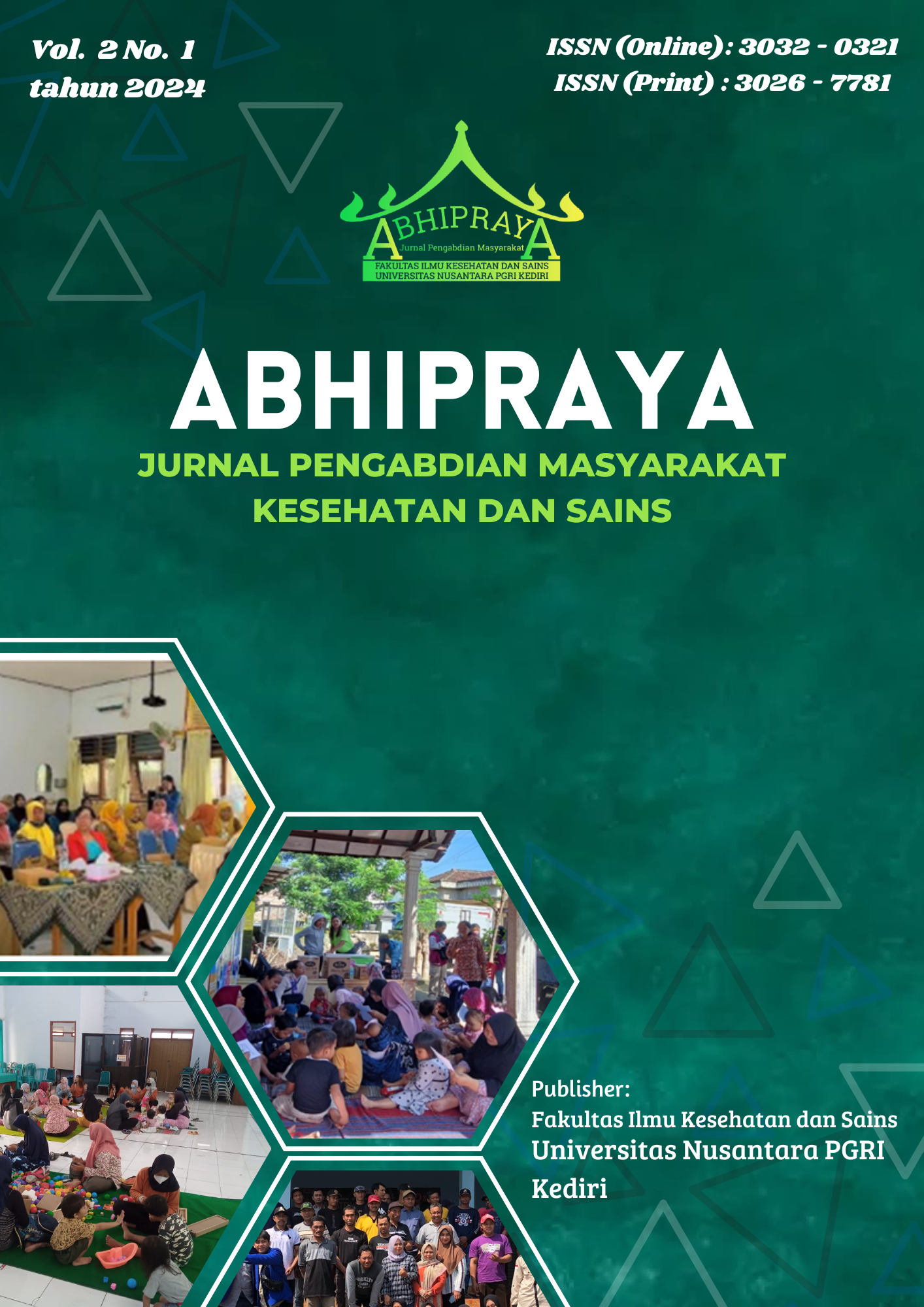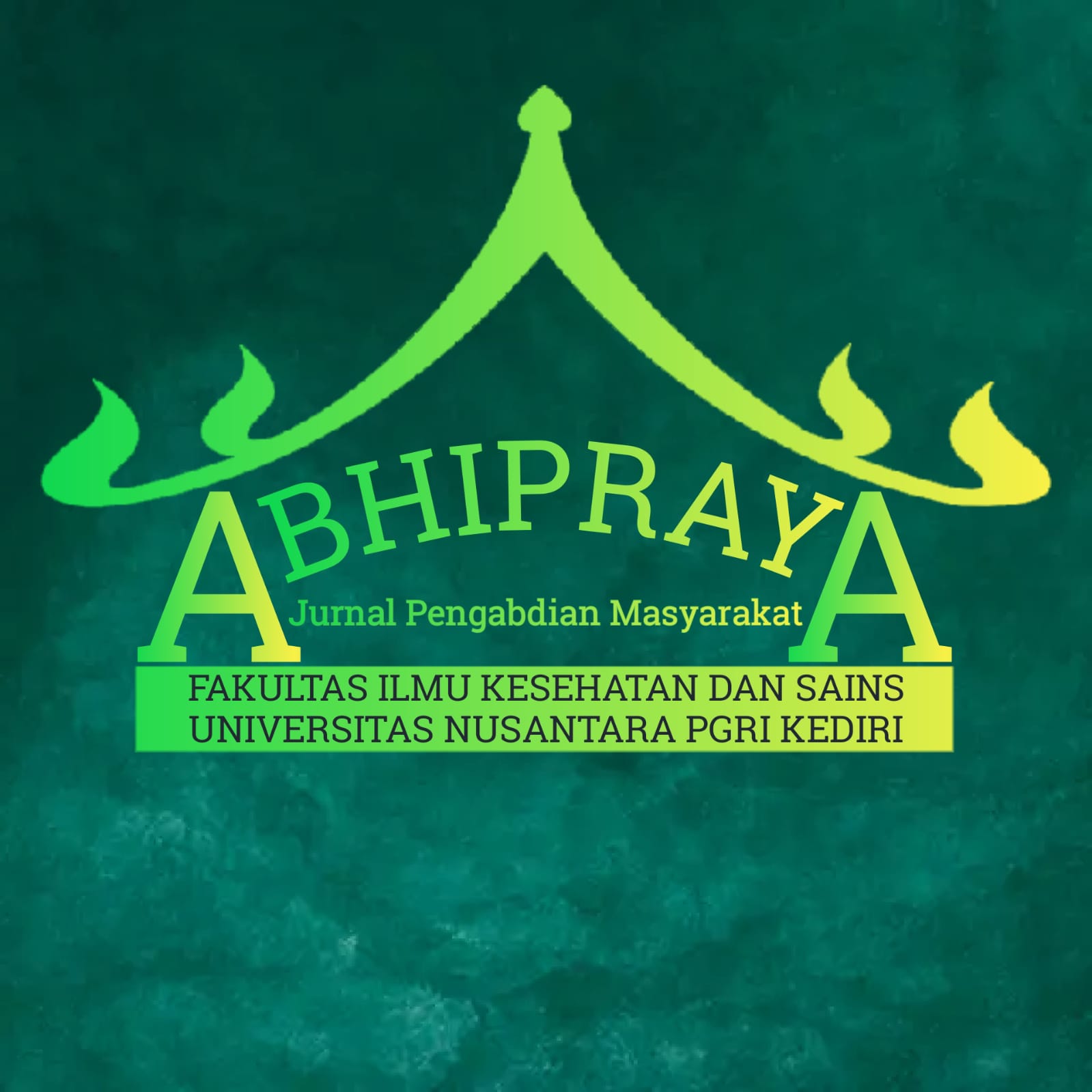Peningkatan Pengetahuan Continuity of Care pada Bidan untuk Cegah AKI-AKB & Stunting
DOI:
https://doi.org/10.29407/abhipraya.v2i1.23758Keywords:
Continuity of Care, Midwife Training, StuntingAbstract
Stunting is one of the indicators to determine the quality of health services.. A strategic effort to overcome this is by implementing Midwife Continuity of Care (CoC) on the 1000 HPK (First Day of Life) by midwives. Probolinggo Regency has the 5th highest mortality rate in East Java Province with an MMR of 201 per 100,000 live births in 2022, while the IMR rate reaches 10.4 per 1,000 live births. One of the factors that influences this problem is the midwife's lack of knowledge regarding CoC care. Research shows that implementing CoC can significantly reduce the risk of maternal and neonatal complications. The aim of this community service activity is to increase midwives' knowledge regarding Continuity of Care. Methods include module development, training, and interactive discussions. The first stage is creating a CoC guide module for midwives and a parenting guide for parents. The second stage involves training for midwives and cadres on the concepts and implementation of CoC. Additionally, the activity is conducted in the form of interactive discussions and reflections on the CoC practices carried out by the midwives and cadres. The final stage is the ASAH (Asih, Asah, and Asuh) class for mothers with infants and toddlers, aimed at enhancing their knowledge in monitoring child growth and development. The results of this activity show an increase in midwives' knowledge of 21% after participating in training and simulations. The midwives involved also showed a commitment to implementing CoC in daily services, with the hope of contributing to improving the quality of sustainable midwifery services in their area. This program is expected to be an important step in and accelerate efforts to prevent MMR, IMR and Stunting in Indonesia
Downloads
References
WHO, UNICEF, UNFPA, World Bank Group, UNDESA/Population Division., Trends in maternal mortality 2000 to 2020 [Internet]. Geneva, Switzerland : World Health Organization; 2023 [cited 2023 Apr 24]. https://www.who.int/ publications/i/item/9789240068759
Kementerian Kesehatan Republik Indonesia. (2021). Laporan Stunting di Indonesia 2021.
Black, M. M., Walker, S. P., Fernald, L. C., et al. (2017). Early childhood development coming of age: Science through the life course. Lancet, 389(10064), 77-90. https://doi.org/10.1016/S0140-6736(16)31389-7
Dinas Kesehatan Kabupaten Probolinggo. (2021). Profil Kesehatan Kabupaten Probolinggo.
Laporan Riskesdas 2018 Nasional. (2018). Profil Kesehatan Puskesmas Banyuanyar Tahun 2022.
World Health Organization. (2020). Improving Early Childhood Development: WHO Guidelines on Physical Growth and Psychosocial Development.
Rayment-Jones, H., Silverio, S. A., Harris, J., Harden, A., & Sandall, J. (2020). Midwives' insight into continuity of care models for women with social risk factors: What works, for whom, in what circumstances, and how. Midwifery, 84, 102654. https://doi.org/10.1016/j.midw.2020.102654.
Hildingsson, I., Karlström, A., & Larsson, B. (2021). Childbirth experience in women participating in a continuity of midwifery care project. Women and Birth, 34(3), e255-e261. https://doi.org/10.1016/j.wombi.2020.06.001
Homer, C. S. (2016). Models of maternity care: Evidence for midwifery continuity of care. Medical Journal of Australia, 205(8), 370-374. https://doi.org/10.5694/mja16.00844
McDonald, M., et al. (2021). The impact of continuity of care by midwives on women’s clinical and psychosocial outcomes: A systematic review. BMC Pregnancy and Childbirth.
PWS KIA Kabupaten Probolinggo 2021
World Health Organization. (2021). Antenatal Care Recommendations. Geneva: WHO.
UNICEF. (2020). Nutrition, for Every Child: Stunting Prevention Guide. New York: UNICEF.
Caldas, L. M., Matulewicz, A. T., Koenig, R. A., Hindle, M., & Donohoe, K. L. (2019). Using immersive simulation to engage student learners in a nonsterile compounding skills laboratory course. Currents in Pharmacy Teaching and Learning, (xxxx), 0–1. https://doi.org/10.1016/j.cptl.2019.12.016
Ikhwan, A. (2017). Metode Simulasi Pembelajaran dalam Perspektif Islam. Jurnal Pendidikan Islam, 2(2)
Cusack, L., Del Mar, C. B., Chalmers, I., et al. (2016). Educational interventions to improve people’s understanding of key concepts in assessing the effects of health interventions: A systematic review protocol. Systematic Reviews, 5(1), 37. https://doi.org/10.1186/s13643-016-0213-9
Rosalina, L., Oktarina, R., Rahmiati, Saputra, I. 2021. Dikutip dari http://repository.unp.ac.id/43171/1/RAHMIATI_BUKU_STATISTIKA_OK.pdf
Pace, C. A., Crowther, S., & Lau, A. (2022). Midwife experiences of providing continuity of carer: A qualitative systematic review. Women and Birth, 35(3), e221-e232. https://doi.org/10.1016/j.wombi.2021.06.005
World Health Organization. (2019). Reducing Stunting in Children: Equity Considerations for Achieving the Global Nutrition Targets 2025.
de Onis, M., & Branca, F. (2016). Childhood stunting: A global perspective. In Maternal and Child Nutrition (Vol. 12, pp. 12–26). Blackwell Publishing Ltd. https://doi.org/10.1111/mcn.12231
Gavine, A., Shinwell, S. C., Buchanan, P., Farre, A., Wade, A., Lynn, F., et al. (2022). Support for healthy breastfeeding mothers with healthy term babies. Cochrane Database of Systematic Reviews (Vol. 2022, Issue 10). John Wiley and Sons Ltd. https://doi.org/10.1002/14651858.CD001141.pub6
Downloads
Published
Issue
Section
License
Copyright (c) 2024 Andriyanti Andriyanti, Dwi Izzati, Woro Setia Ningtyas, Nabilah Sabilillah

This work is licensed under a Creative Commons Attribution-ShareAlike 4.0 International License.
Authors who publish with this journal agree to the following terms:
- Copyright on any article is retained by the author(s).
- The author grants the journal, right of first publication with the work simultaneously licensed under a Creative Commons Attribution License that allows others to share the work with an acknowledgment of the work’s authorship and initial publication in this journal.
- Authors are able to enter into separate, additional contractual arrangements for the non-exclusive distribution of the journal’s published version of the work (e.g., post it to an institutional repository or publish it in a book), with an acknowledgment of its initial publication in this journal.
- Authors are permitted and encouraged to post their work online (e.g., in institutional repositories or on their website) prior to and during the submission process, as it can lead to productive exchanges, as well as earlier and greater citation of published work.
- The article and any associated published material is distributed under the Creative Commons Attribution-ShareAlike 4.0 International License




















